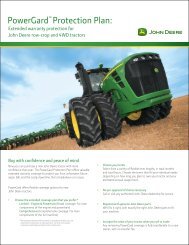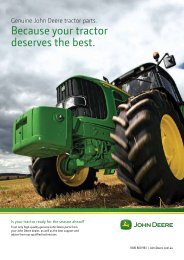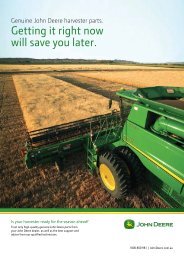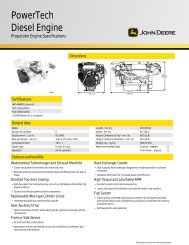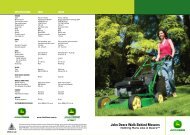You also want an ePaper? Increase the reach of your titles
YUMPU automatically turns print PDFs into web optimized ePapers that Google loves.
By Steve Werblow<br />
<strong>F<strong>in</strong>d<strong>in</strong>g</strong> <strong>dollars</strong> <strong>in</strong> <strong>DNA</strong><br />
Genomes are open<strong>in</strong>g the<br />
door to greater productivity.<br />
36 THE FURROW
Almost daily, it seems,<br />
headl<strong>in</strong>es announce that<br />
a new species of plant,<br />
animal, or pathogen has<br />
had its genome sequenced, the code<br />
of each of its genes spelled out and<br />
mapped. Scientists are follow<strong>in</strong>g<br />
those maps to a treasure trove of<br />
<strong>in</strong>formation.<br />
Now they’re sift<strong>in</strong>g through the<br />
data <strong>in</strong> a race to understand those<br />
genes and put them to work <strong>in</strong><br />
improved crops and livestock.<br />
“I don’t th<strong>in</strong>k sequenc<strong>in</strong>g is<br />
go<strong>in</strong>g to be an issue anymore,” says<br />
Kulv<strong>in</strong>der Gill, a wheat breeder<br />
and geneticist at Wash<strong>in</strong>gton State<br />
University <strong>in</strong> the United States. “The<br />
issue is go<strong>in</strong>g to be how to use it.”<br />
Big hurry. In Gill’s lab, graduate<br />
students and post-doctorates are<br />
dropp<strong>in</strong>g tissue samples from<br />
wheat leaves <strong>in</strong>to t<strong>in</strong>y test tubes,<br />
multiply<strong>in</strong>g the genetic material<br />
from the samples so there’s enough<br />
to test, analys<strong>in</strong>g the genes piped<br />
out of each little vial, and search<strong>in</strong>g<br />
for markers that could be l<strong>in</strong>ked to<br />
genetic success. They’re <strong>in</strong> a hurry –<br />
the plants those samples were taken<br />
from are about to flower, and Gill<br />
LEFT: Breakthroughs <strong>in</strong> genetic research<br />
are start<strong>in</strong>g to yield breed<strong>in</strong>g advances.<br />
BELOW: A <strong>DNA</strong> sample on this glass<br />
slide will be analysed by a high-throughput<br />
sequencer that can identify and unscramble<br />
600 billion base pairs – the build<strong>in</strong>g blocks<br />
of genes – <strong>in</strong> a 12-day run cycle.<br />
wants to use their data to select the<br />
most promis<strong>in</strong>g plants to cross.<br />
At another desk, a researcher is<br />
study<strong>in</strong>g the corn genome, look<strong>in</strong>g<br />
for a gene that could confer a new<br />
type of dwarf<strong>in</strong>g characteristic<br />
to wheat. Welcome to breed<strong>in</strong>g,<br />
genomics style.<br />
The tools Gill’s team uses are a<br />
triumph of modern science.<br />
<strong>DNA</strong> is made up of millions of<br />
pairs of just four chemical bases,<br />
labeled A, C, T, and G. That means<br />
every gene is a str<strong>in</strong>g of hundreds<br />
or thousands of those letters. Every<br />
chromosome is a collection of<br />
thousands of genes, along with a<br />
bunch of “junk code” like silenced<br />
genes, old bits of viruses, and other<br />
<strong>DNA</strong> that doesn’t seem to have a role<br />
<strong>in</strong> the organism’s growth.<br />
Some genomes, like those <strong>in</strong> people<br />
and cows, have two copies of each<br />
chromosome, one from mum and one<br />
from dad. Others, like wheat, have six<br />
copies of each. That’s billions of As,<br />
Cs, Ts, and Gs on a gene map. In the<br />
test tube, they’re just alphabet soup.<br />
“Let’s say you took an<br />
encyclopedia, all 26 volumes,” says<br />
Brian Scheffler, who heads the<br />
U.S. Department of Agriculture<br />
Agricultural Research Service’s<br />
Genomics and Bio<strong>in</strong>formatics Unit <strong>in</strong><br />
Stoneville, Mississippi. “Each volume<br />
is a chromosome. Each page is a<br />
gene. Now run them through a paper<br />
shredder – and we’re not talk<strong>in</strong>g<br />
strips, we’re talk<strong>in</strong>g confetti. Then<br />
you have to put it all back together.”<br />
If that’s not challeng<strong>in</strong>g enough,<br />
remember that for plants like cotton,<br />
which has chromosomes from two<br />
different ancestor species <strong>in</strong> every<br />
cell, you’re reconstruct<strong>in</strong>g complete<br />
encyclopedia sets from different<br />
publishers.<br />
That’s why complet<strong>in</strong>g a genome<br />
is such a milestone – a good map<br />
makes sequenc<strong>in</strong>g the next <strong>in</strong>dividual<br />
from that species much easier, and<br />
provides a basis for compar<strong>in</strong>g the<br />
similarities and differences among<br />
chromosomes.<br />
“Resequenc<strong>in</strong>g is like do<strong>in</strong>g a<br />
puzzle and hav<strong>in</strong>g the box top <strong>in</strong><br />
front of you,” Scheffler expla<strong>in</strong>s.<br />
A day’s work. Technology has<br />
gotten faster and cheaper, eas<strong>in</strong>g<br />
the effort. “My Ph.D. thesis would<br />
be about a day’s work for my lab<br />
now,” Scheffler says, add<strong>in</strong>g that<br />
the $100 million rice genome project<br />
completed <strong>in</strong> 2005 would cost about<br />
$2 million today.<br />
That speed and economy propels<br />
Gill’s real-time breed<strong>in</strong>g choices. It<br />
also allows geneticists to analyse the<br />
genotypes of 5,000 to 7,000 U.S. dairy<br />
cows and bulls per month, us<strong>in</strong>g<br />
computerised chips to see which gene<br />
markers are present <strong>in</strong> each animal.<br />
Breeders have spent years correlat<strong>in</strong>g<br />
BELOW: Analys<strong>in</strong>g 60,000 gene markers<br />
<strong>in</strong> a chicken’s genome allows producers to<br />
choose breed<strong>in</strong>g animals <strong>in</strong> 20 weeks rather<br />
than 2 years.<br />
illustration: paul lange<br />
THE FURROW 37
those markers – s<strong>in</strong>gle nucleotide<br />
polymorphisms (SNPs), or “snips”<br />
– aga<strong>in</strong>st thousands of pedigree<br />
records and performance tests.<br />
As a result, they’ve ratcheted up the<br />
accuracy of predict<strong>in</strong>g genetic fitness<br />
<strong>in</strong> dairy cattle to 83 percent us<strong>in</strong>g<br />
computer-analysed “SNP chips,”<br />
compared to a success rate of 35<br />
percent or 40 percent with pedigrees,<br />
says Curt Van Tassell at the USDA-<br />
ARS Bov<strong>in</strong>e Functional Genomics<br />
Laboratory <strong>in</strong> Beltsville, Maryland.<br />
Driven by genomic analysis, the<br />
rate of productivity ga<strong>in</strong> <strong>in</strong> the dairy<br />
<strong>in</strong>dustry is expected to double over<br />
the next few years, he adds. “It’s<br />
already be<strong>in</strong>g felt as the sons of top<br />
bulls are kick<strong>in</strong>g their dads off the<br />
top of the list quickly,” Van Tassell<br />
notes.<br />
Fast and cheap. A SNP chip<br />
analysis of a bull’s genome costs $300<br />
to $500. That’s cheap – compared to<br />
the $50,000 now spent collect<strong>in</strong>g data<br />
on a bull’s daughters – and faster.<br />
“We can identify an up-andcom<strong>in</strong>g<br />
bull essentially from the date<br />
of birth <strong>in</strong>stead of wait<strong>in</strong>g five or six<br />
years like we did <strong>in</strong> the past, when<br />
we had to wait for his daughters<br />
to yield milk<strong>in</strong>g data,” Van Tassell<br />
expla<strong>in</strong>s.<br />
Chicken producers can use<br />
SNP chips, too. At $56 per bird, a<br />
BELOW: Golden capillaries channel<br />
fragments of <strong>DNA</strong> to an analyser. Teased<br />
apart by a gentle electrical charge, they form<br />
a “genetic f<strong>in</strong>gerpr<strong>in</strong>t.”<br />
few thousand birds at a time, the<br />
economics of a 60,000-marker<br />
SNP test are a bit more daunt<strong>in</strong>g,<br />
accord<strong>in</strong>g to poultry and aquaculture<br />
breeder Bill Muir at Purdue<br />
University, Indiana, though genomic<br />
selection has more than doubled the<br />
annual rate of ga<strong>in</strong> <strong>in</strong> the <strong>in</strong>dustry.<br />
“Where this technology has the<br />
greatest potential to br<strong>in</strong>g about<br />
good is traits that are expensive to<br />
measure, difficult to measure, or that<br />
don’t exhibit until later <strong>in</strong> life,” Muir<br />
says.<br />
Feed efficiency, carcass quality, egg<br />
production, or low-heritability traits<br />
like leg soundness are prime targets.<br />
Muir is develop<strong>in</strong>g smaller SNP<br />
chips with markers correspond<strong>in</strong>g to<br />
specific traits like egg production or<br />
feed efficiency. His goal is to br<strong>in</strong>g<br />
the price down to a few <strong>dollars</strong>.<br />
But don’t confuse the success of<br />
SNP chips or marker-assisted<br />
breed<strong>in</strong>g – us<strong>in</strong>g SNPs to track<br />
key bits of <strong>DNA</strong> through the plant<br />
breed<strong>in</strong>g process technology that’s<br />
already yielded blockbuster hybrids<br />
and Clearfield wheat – with a deep<br />
understand<strong>in</strong>g of how genes actually<br />
work.<br />
“We’re try<strong>in</strong>g to decipher all<br />
the <strong>in</strong>formation that’s com<strong>in</strong>g <strong>in</strong><br />
and decide what it means,” says<br />
<strong>John</strong> Soper, vice president of crop<br />
genetics R&D for Pioneer Hi-Bred<br />
International <strong>in</strong> <strong>John</strong>ston, Iowa. “The<br />
scientists work<strong>in</strong>g on this will start<br />
to focus on ‘what is a gene really<br />
all about? What is the recipe for a<br />
38 THE FURROW
esistance gene?’ Perhaps the last<br />
piece of the puzzle, the complex<br />
piece of the puzzle, is start<strong>in</strong>g to<br />
understand how genes <strong>in</strong>teract.”<br />
Scheffler agrees.<br />
“When I did my Ph.D., from 1986<br />
to 1989, science moved forward<br />
one gene at a time,” he says. “Now<br />
we’re ask<strong>in</strong>g the question, ‘what’s<br />
happen<strong>in</strong>g when the whole th<strong>in</strong>g<br />
comes together?’ That’s important<br />
because when you get down to<br />
yield, it’s not just one gene – yield<br />
is multiple genes, multiple levels of<br />
expression.”<br />
Global questions. “Now we can<br />
start pull<strong>in</strong>g th<strong>in</strong>gs apart,” Scheffler<br />
cont<strong>in</strong>ues. “We can start ask<strong>in</strong>g<br />
global questions like, ’when a plant<br />
is experienc<strong>in</strong>g drought, which genes<br />
have an impact on yield?’ We can<br />
start solv<strong>in</strong>g problems we couldn’t<br />
address before.”<br />
Every crop sequenced and every<br />
gene identified br<strong>in</strong>gs all breeders a<br />
step closer to the next advance, adds<br />
Gill.<br />
“Once a gene is cloned <strong>in</strong> rice, it’s<br />
more than likely it will work the<br />
same <strong>in</strong> wheat,” he says. “We are<br />
go<strong>in</strong>g to learn from each other.”<br />
ABOVE: Genomics allows plant<br />
breeders to start manag<strong>in</strong>g crosses <strong>in</strong><br />
the lab or greenhouse, not the test plot.<br />
BELOW: Kulv<strong>in</strong>der Gill of Wash<strong>in</strong>gton<br />
State University says cost-sav<strong>in</strong>g genomics<br />
tools can help breeders develop varieties<br />
with genes ideal for specific regions or<br />
niche crops.<br />
THE FURROW 39



